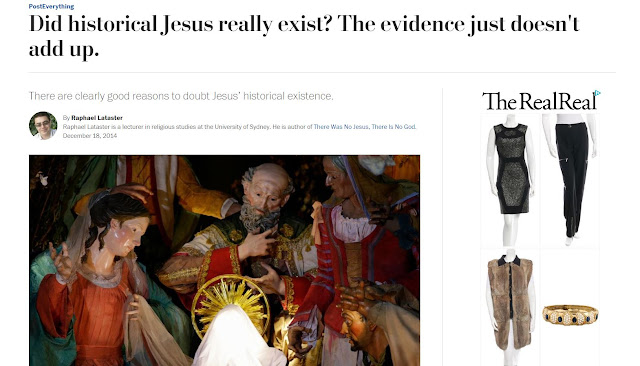Raphael Lataster: A quick correction or two relating to credibility
In the online version of the Washington Post, under the date December 18, 2014, one finds an article entitled "Did historical Jesus really exist? The evidence just doesn't add up." It's author is a certain Raphael Lataster, who is described as having written a book called There Was No Jesus, There Is No God. And we are told that he is "a lecturer in religious studies at the University of Sydney." Very quickly after beginning the article one's confidence in the author gets punctured when he informs his reader that "the criterion of multiple independent attestation," is no good "given that the sources clearly are not independent." Actually in some cases yes they are! Certainly the criterion has its limitations, does the author understand its actual application in terms of evaluating independent Christian literary compositions?
The tear gets bigger soon after when the author describes the great first-century Jewish historian Josephus as a "Roman Scholar."
Even though its only a short article, the author still manages to force out the last gasp of the readers confidence when he says that "Only Bart Ehrman an Maurice Casey have thoroughly attempted to prove Jesus’ historical existence in recent times." One has to ask, is our author familiar with the enormous boom of historical Jesus studies that has taken place during the past few decades examining every aspect of the evidence relevant to the question? Has he ever encountered, for example, the works of N. T. Wright, John P. Meier, Jame D. G. Dunn? Had he said that Casey and Ehrman were the only ones who took the trouble to read the books of mythicists and respond to their arguments point by point it would have been closer to the truth. But even that wouldn't be quite true, since a great number of other scholars have undertaken to answer the mythicists, especially during the period of the The Da Vinci Code when such arguments were being highlighted. In fact it is questionable to say that Ehrman and Casey sought to "prove" Jesus's existence, since that is not in question. Rather they laid out arguments to show that the claims being put forward against his existence were, as the majority of scholars knew already, baseless and irresponsible.
After reading the article the question arises as to whether perhaps the Washington Post rather than Lataster was responsible for one or more of the article's scholarly infelicities. The writer sought the answer on Lataster's website, which makes no correction, but merely offers a link to the article with the following absurdly self-aggrandizing description of the article as: "A milestone for this controversial idea. If not the first, certainly one of the first half-decent treatments of the issue in the mainstream media. The article reached over half a million people, and ‘broke’ the comment counter, in prompting over 5,000 comments."




Comments
Post a Comment